Top Rankings
Big Spring School District ranks among the top 20% of public school district in Pennsylvania for:
Category
Attribute
Science Proficiency
Highest science proficiency (Top 20%)
For the 2025 school year, there is 1 public middle school serving 543 students in Big Spring School District. This district's average middle testing ranking is 8/10, which is in the top 30% of public middle schools in Pennsylvania.
Public Middle School in Big Spring School District have an average math proficiency score of 32% (versus the Pennsylvania public middle school average of 26%), and reading proficiency score of 65% (versus the 52% statewide average).
Minority enrollment is 8% of the student body (majority Hispanic), which is less than the Pennsylvania public middle school average of 46% (majority Black and Hispanic).
Overview
This School District
This State (PA)
# Schools
5 Schools
923 Schools
# Students
2,343 Students
591,579 Students
# Teachers
188 Teachers
44,337 Teachers
Student : Teacher Ratio
12:1
12:1
District Rank
Big Spring School District, which is ranked within the top 30% of all 675 school districts in Pennsylvania (based off of combined math and reading proficiency testing data) for the 2021-2022 school year.
The school district's graduation rate of 89% has decreased from 92% over five school years.
Overall District Rank
#171 out of 684 school districts
(Top 30%)
(Top 30%)
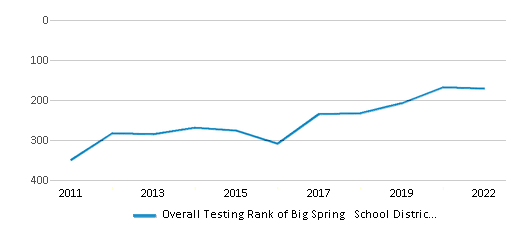
Math Test Scores (% Proficient)
45%
36%
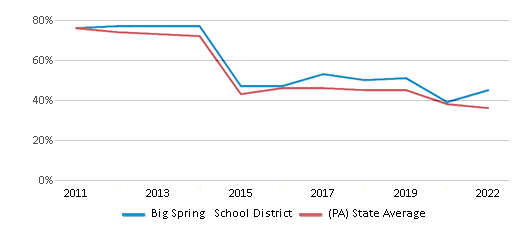
Reading/Language Arts Test Scores (% Proficient)
62%
55%
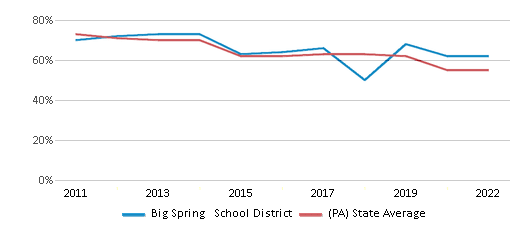
Science Test Scores (% Proficient)
74%
57%

Graduation Rate
89%
87%
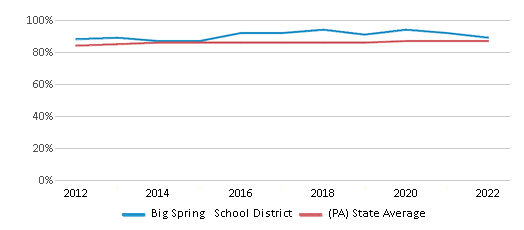
Students by Ethnicity:
Diversity Score
0.15
0.65
# American Indian Students
n/a
1,239 Students
% American Indian Students
n/a
n/a
# Asian Students
17 Students
25,214 Students
% Asian Students
1%
4%
# Hispanic Students
58 Students
97,970 Students
% Hispanic Students
2%
17%
# Black Students
15 Students
118,593 Students
% Black Students
1%
20%
# White Students
2,154 Students
316,870 Students
% White Students
92%
54%
# Hawaiian Students
1 Student
586 Students
% Hawaiian Students
n/a
n/a
# Two or more races Students
98 Students
30,545 Students
% of Two or more races Students
4%
5%
Students by Grade:
# Students in PK Grade:
-
1,623
# Students in K Grade:
145
15,933
# Students in 1st Grade:
159
17,465
# Students in 2nd Grade:
171
18,204
# Students in 3rd Grade:
173
18,156
# Students in 4th Grade:
208
19,235
# Students in 5th Grade:
192
33,809
# Students in 6th Grade:
168
92,720
# Students in 7th Grade:
178
128,929
# Students in 8th Grade:
197
129,773
# Students in 9th Grade:
212
34,725
# Students in 10th Grade:
189
28,504
# Students in 11th Grade:
181
26,584
# Students in 12th Grade:
170
25,919
# Ungraded Students:
-
-
District Revenue and Spending
The revenue/student of $24,355 is higher than the state median of $23,696. The school district revenue/student has stayed relatively flat over four school years.
The school district's spending/student of $22,112 is less than the state median of $23,119. The school district spending/student has stayed relatively flat over four school years.
Total Revenue
$57 MM
$39,541 MM
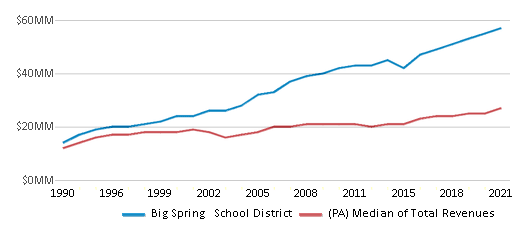
Spending
$52 MM
$38,578 MM
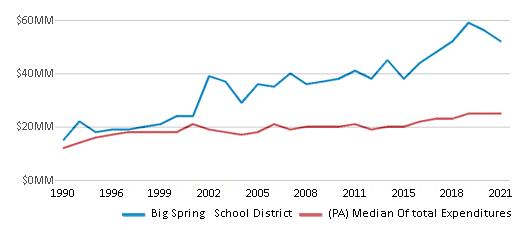
Revenue / Student
$24,355
$23,696
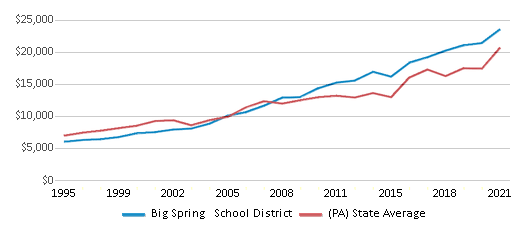
Spending / Student
$22,112
$23,119

Best Big Spring School District Public Middle Schools (2025)
School
(Math and Reading Proficiency)
(Math and Reading Proficiency)
Location
Grades
Students
Rank: #11.
Big Spring Middle School
(Math: 32% | Reading: 65%)
Rank:
Rank:
6/
Top 50%10
43 Mount Rock Rd
Newville, PA 17241
(717) 776-2471
Newville, PA 17241
(717) 776-2471
Grades: 6-8
| 543 students
Recent Articles

Year-Round Or Traditional Schedule?
Which is more appropriate for your child? A year-round attendance schedule or traditional schedule? We look at the pros and cons.

Why You Should Encourage Your Child to Join a Sports Team
Participating in team sports has a great many benefits for children, there is no doubt. In this article you will learn what those benefits are.

White Students are Now the Minority in U.S. Public Schools
Increasing birth rates among immigrant families from Asia and Central and South America, combined with lower birth rates among white families, means that for the first time in history, public school students in the United States are majority-minority. This shift in demographics poses difficulties for schools as they work to accommodate children of varying language abilities and socio-economic backgrounds.





